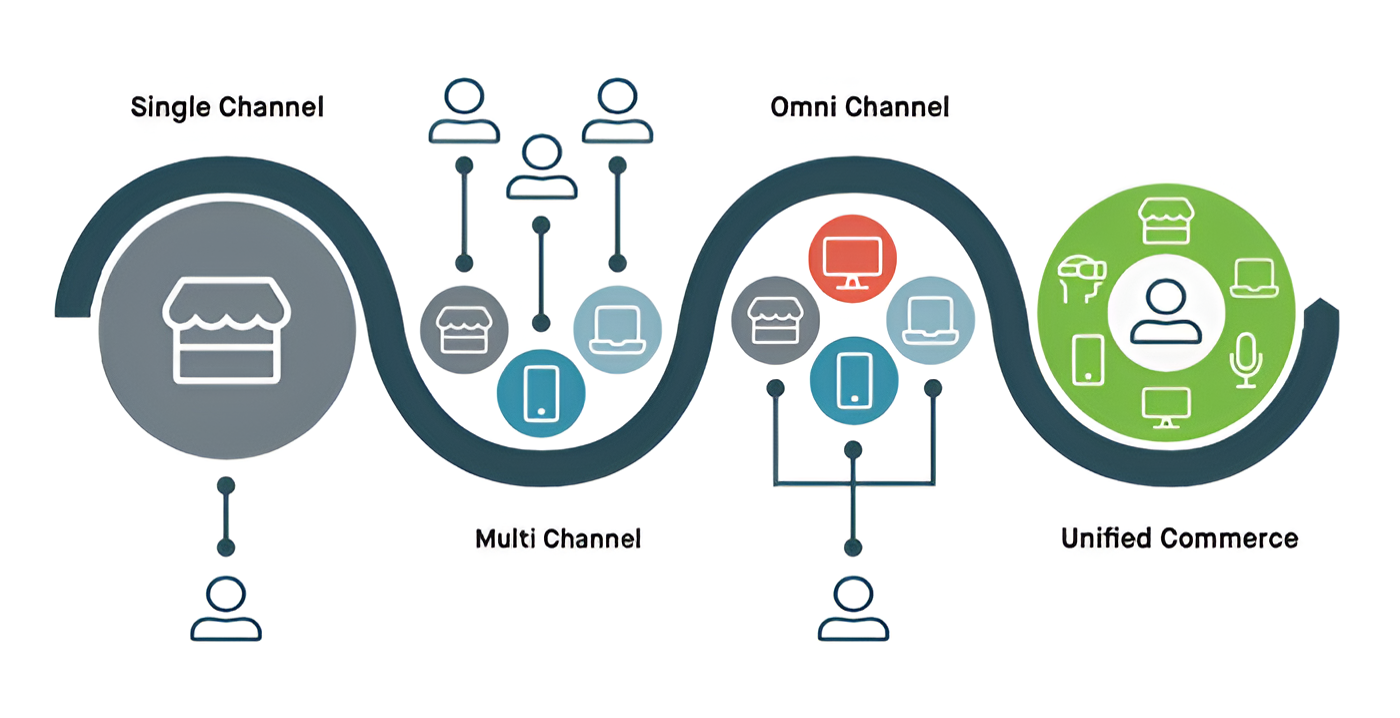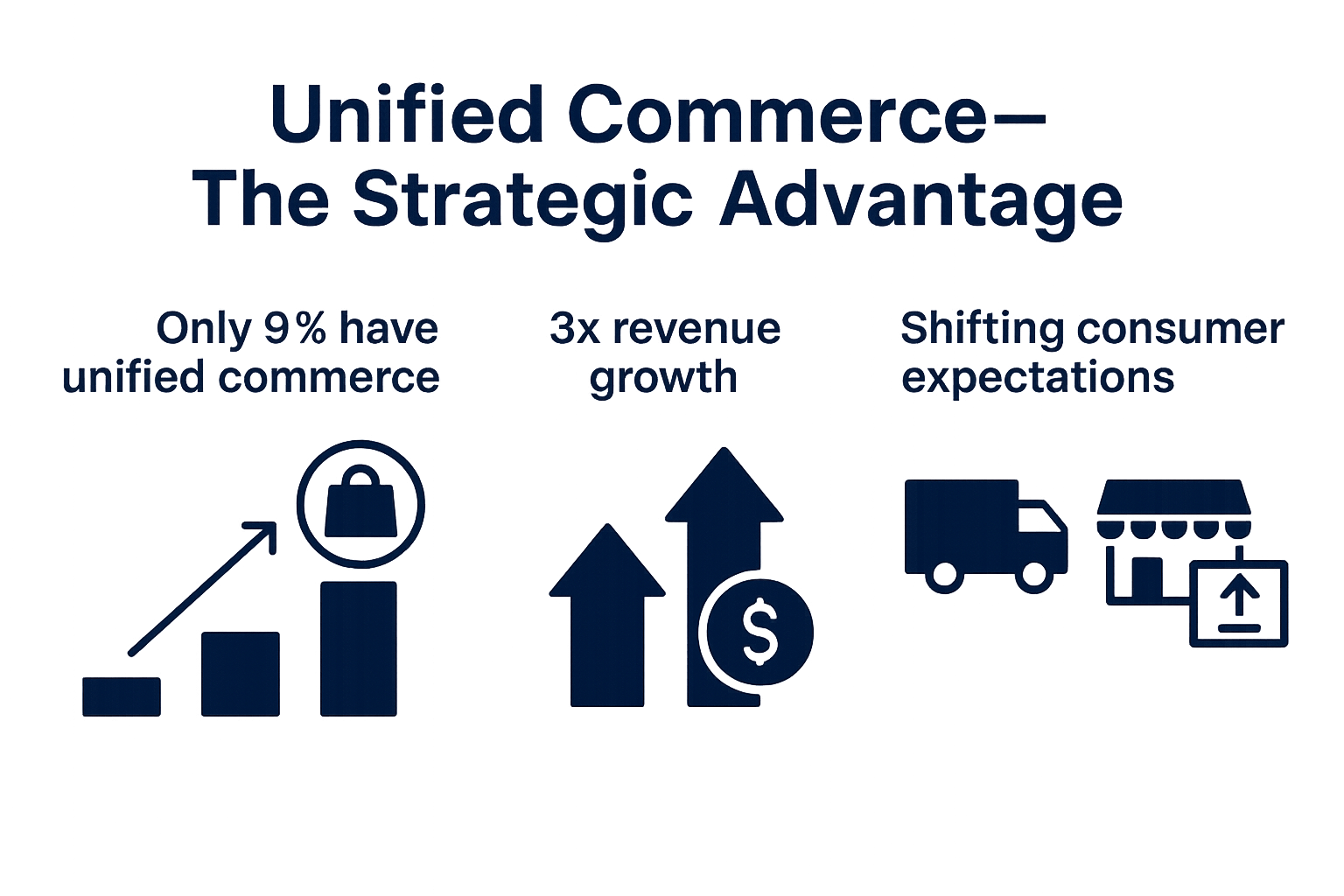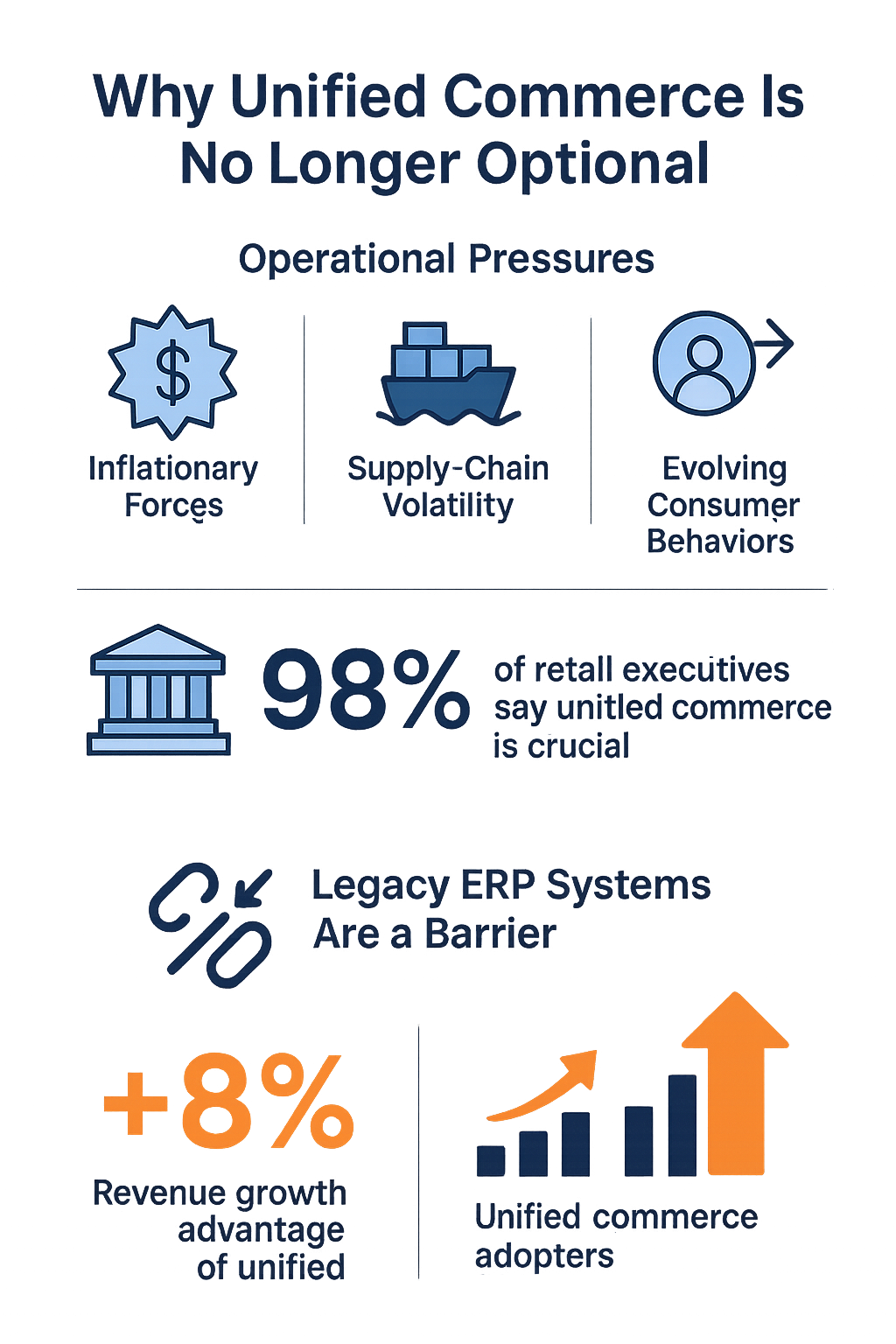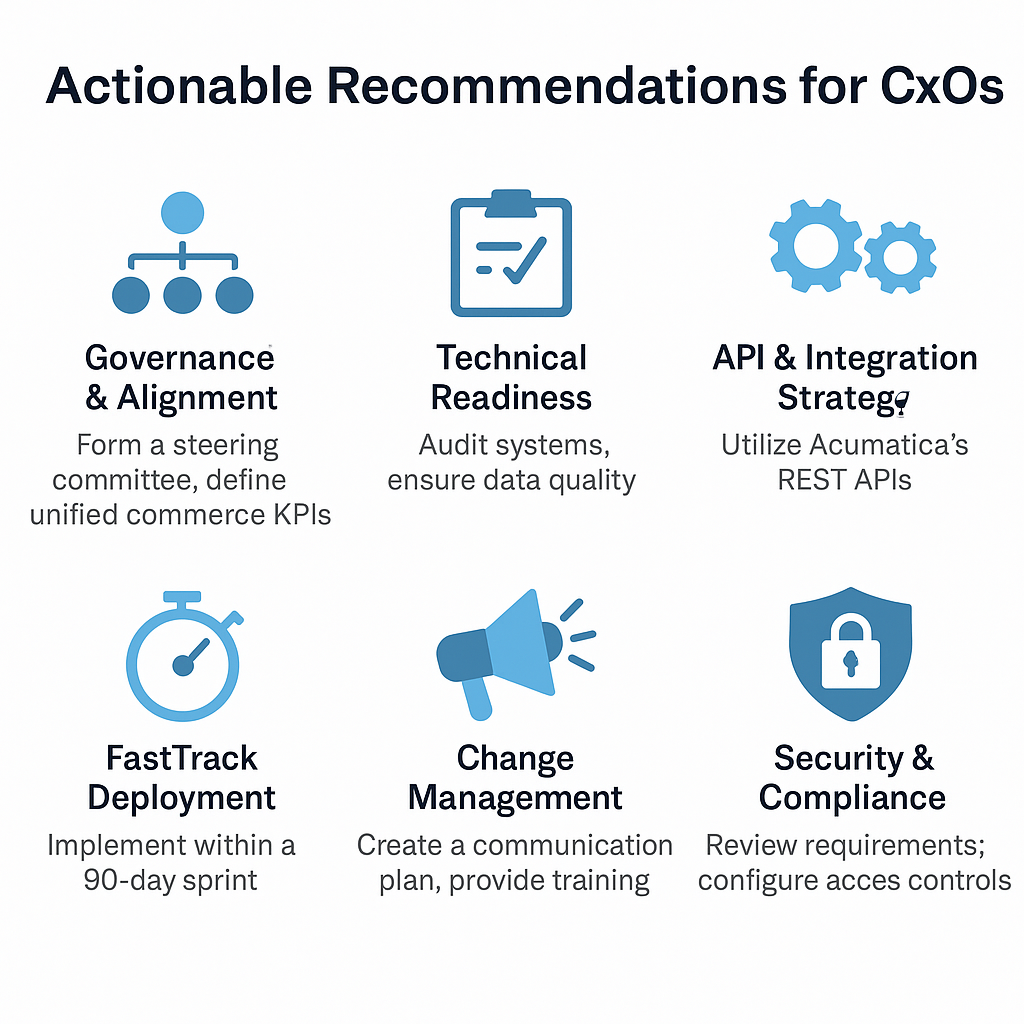Scaling Unified Commerce with Acumatica Cloud ERP

The Strategic Imperative: Unified Commerce at Scale
Unified commerce has rapidly become essential for enterprises navigating margin pressures, rising customer expectations, and economic uncertainty. Yet, fewer than 10% of specialty retailers have successfully unified their online and offline channels. Those who do achieve this integration outpace competitors by a factor of three, unlocking up to $55 million in incremental revenue per billion in sales.
Consumer demand for seamless, frictionless cross-channel interactions is accelerating: 66% of U.S. consumers prioritize the convenience of buying out-of-stock items in-store for home delivery, while 67% demonstrate greater loyalty toward brands enabling online returns in physical locations.

Acumatica Cloud ERP uniquely positions enterprises to capitalize on this trend. Its cloud-native architecture, open API ecosystem, and AI-driven automation capabilities enable businesses to integrate e-commerce, point-of-sale, and back-office workflows into a unified, real-time operational platform. Compared to legacy ERP alternatives, Acumatica offers lower total cost of ownership, faster deployment, and greater agility—delivering measurable improvements in margins, efficiency, and customer experience.

This briefing outlines key market drivers, compares leading ERP platforms, quantifies achievable ROI, and provides actionable recommendations to empower technology leaders in scaling unified commerce capabilities.
Why Unified Commerce Is No Longer Optional
U.S. retailers and manufacturers are confronting unprecedented operational pressures. Inflationary forces, supply-chain volatility, and evolving consumer behaviors are squeezing margins, complicating inventory management, and demanding increasingly sophisticated customer experiences. While 98% of retail executives acknowledge unified commerce as crucial to profitability, fewer than half report that their current technology infrastructure adequately supports true omnichannel integration.
Legacy ERP systems have become the single largest barrier—fragmented architectures deliver inconsistent data, constrain innovation, and drive up operational costs. Companies without unified commerce capabilities face significant competitive disadvantages, leaving substantial revenue opportunities untapped. Research from Retail TouchPoints indicates unified commerce adopters enjoy an average 8-percentage-point revenue growth advantage, and those successfully integrating payments across channels experience as much as 16% incremental revenue growth.

At its core, unified commerce means orchestrating inventory, orders, payments, and customer interactions seamlessly across digital and physical touchpoints. This includes enabling frictionless experiences like buy-online-pickup-in-store (BOPIS), ship-from-store, and endless aisle fulfillment. Achieving these capabilities demands a modern, cloud-native ERP platform designed explicitly for integration, extensibility, and real-time intelligence.
Acumatica Cloud ERP addresses these demands head-on, offering enterprises the agility required to rapidly scale unified commerce initiatives. By migrating away from outdated ERP solutions, organizations can substantially reduce technical debt, enhance operational flexibility, and lay the foundation for future innovation driven by AI and advanced analytics.
Market Context & Drivers
Macroeconomic pressures. Despite e-commerce growth, brick‑and‑mortar stores still account for about 72% of U.S. retail sales and will generate over $4.2 trillion by 2028. The rise of click‑and‑collect is significant: Forrester predicts it will exceed $100 billion in 2023 and double by 2028. Consumers increasingly expect options like same-day pickup, ship‑to‑home, and curbside returns.
Consumer behavior shifts. A Bain & Company study reports that unified commerce improves purchase sizes, conversion, and loyalty by creating a single view of customers and inventory. Data shows 66% of U.S. consumers value ordering out-of-stock items for home delivery and 67% prefer in-store web returns, while 55% will abandon purchases if their preferred payment method is unavailable.
Technology investment trends. Only 25% of retailers maintain a centralized database with cross-channel sales. Yet 42% of U.S. retailers are investing in connecting online and in-person payments into a unified system, and 36% are investing in payments data collection and analytics. The 2025 Unified Commerce Benchmark from Retail Touch Points shows that best-in-class specialty retailers grow three times faster than competitors and can generate $13 million to $55 million in incremental revenue per billion in sales.
Cloud adoption momentum. Gartner estimates that more than $1.3 trillion in enterprise IT spending is shifting to the cloud, projected to grow to $1.8 trillion by 2025. The global cloud ERP market, valued at $34.83 billion in 2023, is projected to grow at 18% annually through 2030. Cloud ERP delivers 30–50% cost savings in the first year, and 53% of organizations report positive ROI. Forrester’s Total Economic Impact (TEI) of Acumatica found a 66% ROI and a 16-month payback period.

Technical Architecture: How Acumatica Unifies Commerce
Acumatica was born in the cloud with an open, service‑oriented architecture. Its contract‑based REST API supports OpenAPI 2.0 specifications and OAuth 2.0 authorization, exposing the same business logic used in the user interface through REST and SOAP endpoints. This allows developers to integrate e‑commerce sites, POS systems, marketplaces ,and external services with minimal friction. The platform participates in the OpenAPI Initiative, supporting low‑code/no‑code integration and enabling interoperability with over 80 third-party applications out of the box; nearly 300 connectors are available via the Acumatica Marketplace.
At the heart of unified commerce is real-time inventory and order orchestration. Acumatica’s Retail Edition synchronizes product catalogs, pricing, orders ,and inventory across Shopify, BigCommerce ,and other platforms, allowing businesses to manage digital and physical storefronts from a single platform. Point of Sale (POS) capabilities unify data from brick‑and‑mortar stores with online transactions, ensuring accurate stock levels and enabling cross‑channel promotions. The platform’s bi‑directional data flows and open APIs ensure that customer profiles, loyalty points, pricing and tax calculations remain consistent across channels.
The 2025 R1 release enhances this foundation with AI‑driven insights and automation. Acumatica AI Studio provides anomaly detection and accounts payable document recognition, allowing finance teams to flag irregularities and automate invoice processing. Low‑code/no‑code tools and improved navigation empower users to modify workflows without developer intervention. Industry‑specific updates extend capabilities for retail, distribution and manufacturing, such as seamless Shopify integrations, Amazon fulfillment synchronization ,and advanced scheduling views.
Comparison with NetSuite and SAP Business One
NetSuite SuiteCommerce. NetSuite’s unified commerce platform integrates e‑commerce with NetSuite’s ERP, order management and CRM systems. It offers a single view of customer orders and inventory and exposes robust developer tools, including single‑page architecture and code‑level customization. NetSuite’s strength lies in its maturity and depth of modules; however, its licensing is per‑user rather than usage‑based, and customizations often require specialized developers. SuiteCommerce is tightly coupled to NetSuite’s ecosystem, limiting flexibility when integrating best‑of‑breed POS or marketplace solutions.
SAP Business One. SAP B1 for retail supports e‑commerce integration, in‑store POS, CRM and real‑time analytics. Its underlying architecture is monolithic compared with Acumatica’s microservices‑inspired design, and customization typically involves ABAP or proprietary tools. While SAP B1 offers strong financial management and supply chain capabilities, its on‑premise heritage can slow innovation and increase total cost of ownership. Licensing is also user‑based, and connecting multiple systems often requires expensive middleware.
Acumatica advantages. Unlike NetSuite and SAP B1, Acumatica uses consumption‑based pricing, so companies pay for the resources they use rather than per user. Its open, modular architecture, built on the Microsoft .NET platform, enables partners and customers to develop custom modules and integrations using familiar tools. The xRP platform and OpenAPI support allow integration with emerging commerce channels, marketplaces and AI services. Acumatica’s 2025 R1 release adds AI‑driven insights, anomaly detection and low‑code customization, further differentiating it as a future‑ready platform.
Data‑Driven ROI & Benchmarks
Evidence for cloud ERP ROI is compelling. Nucleus Research estimates cloud deployments deliver 4x the ROI of on‑premise systems, and over half of SMBs reported a 150% ROI increase after adopting cloud ERP. Cost analysis studies show cloud implementations reduce five-year total costs by 67–75% versus on‑premise deployments and eliminate capital expenditures for hardware and upgrades. Companies typically achieve 30–50% cost savings in the first year, and 53% of organizations report positive ROI in 16 months.
Forrester’s TEI of Acumatica, based on interviews with four customers, found that the composite organization realized benefits of $3.5 million over three years against costs of $2.1 million, delivering a net present value (NPV) of $1.4 million and an ROI of 66% with payback in 16 months. Quantified benefits included a 15% increase in gross margin, a 45% improvement in employee productivity, a 15% increase in sales, and a significant avoidance of legacy licensing costs.

Overall, cost-to-serve improvements include lower order processing costs resulting from automation, reduced inventory holding costs due to improved visibility, and lower tax compliance costs through integrated solutions. Enterprises report that unified commerce reduces in-store staffing requirements and increases conversion rates, resulting in a 9–12% improvement in gross margin.
Actionable Recommendations for CxOs
To capitalize on unified commerce and ensure a successful Acumatica deployment, technology leaders should take deliberate steps. The following recommendations encompass both immediate actions and next-quarter initiatives.
· Governance and alignment: Establish an executive steering committee representing finance, IT, merchandising, fulfillment, and customer experience to align unified commerce goals. Define KPIs such as conversion rate lift, inventory turns, and gross margin improvement, and embed them into governance dashboards.
· Technical readiness: Conduct a systems audit to map all commerce touchpoints, ERP modules, and third-party applications. Identify redundant systems and plan phased decommissioning. Ensure data quality by standardizing customer and product masters.
· API & integration strategy: Adopt Acumatica’s REST APIs and open connectors to integrate existing e-commerce, POS, and marketplace platforms. Prioritize bidirectional integration for inventory, pricing, promotions, and taxes to avoid inconsistent data.
· FastTrack deployment: Leverage Acumatica’s FastTrack or partner-led agile implementation methodologies to accelerate time to value. Aim to complete configuration, data migration, and user training within a 90-day sprint, employing iterative testing and change management.
· Change management: Create a communication plan to educate employees on unified processes, set expectations, and train staff on new workflows. Empower super‑users and champions in each department to drive adoption and collect feedback for continuous improvement.
· Data and AI readiness: Invest in data governance and analytics capabilities to leverage Acumatica’s AI Studio. Identify high-impact use cases such as inventory forecasting, anomaly detection, and spend analysis, and plan for custom AI models or marketplace extensions.
· Security and compliance: Review security and regulatory requirements (e.g., PCI‑DSS, SOC 2, GDPR). Configure multi-factor authentication, role-based access control, and audit trails. Assess third-party applications for compliance and integrate tax automation to reduce risk.
· Scalability and innovation: Develop a roadmap for expanding commerce channels (e.g., social commerce, marketplaces) and geographic markets. Use Acumatica’s marketplace connectors and low-code platform to experiment with new business models and plan for future AI and machine learning integrations.
Conclusion and Next Steps
Unified commerce is no longer optional; it is a competitive necessity. Consumers reward retailers that offer seamless experiences across channels, and investors favor companies with efficient, data-driven operations. Acumatica’s cloud‑native ERP delivers the integration, scalability, and intelligence required to meet these demands. By consolidating disparate systems, enabling real-time visibility ,and leveraging AI-driven insights, enterprises can unlock new revenue, reduce costs, and accelerate growth.

MLVeda offers deep expertise in unified commerce and Acumatica implementations. We help CxOs assess readiness, develop migration roadmaps, and orchestrate change management to ensure successful outcomes. Contact us to schedule a unified commerce readiness workshop and explore how Acumatica can power your next stage of growth.


